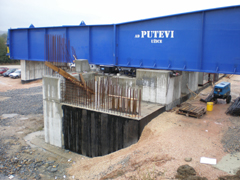

|
|
Products > Pile load tester > Data loggers > Fast bridge construction > Fast build construction > Jack up lifting > Servo technic Photo gallery Download References About us Contact |

|
Fast bridge construction |
Date 17. Oct. 2025. |
Fast Bridge Construction Method - Incremental Launching!HistoryIt is estimated that over 1,000 bridges worldwide have been constructed using the incremental launching method. Swanson (1979) states that the first incrementally launched highway bridge in the United States was constructed near Covington, Indiana in 1977. One of the earliest published reports in North America, however, describes the construction of a railroad truss span for the Canadian Pacific Railway in 1907. Despite the advantages listed, the incremental launching method of construction has seen very limited application in the United States. The reason for this disparity is unclear and it is one of the goals of the proposed work to ascertain the reasons for and attempt to eliminate this potential “knowledge gap” for bridge owners, designers and contractors. Specifically, the project objective is to provide bridge owners, designers, and contractors with information and understanding about the incremental launching method, including applications and benefits. SummaryBridge construction over water crossings, deep valleys… can offer many challenges. The incremental launching bridge construction method may offer advantages over conventional construction. This method involves assembly of the bridge superstructure on one side of an obstacle to be crossed, and then movement of the superstructure longitudinally into its final position. Despite potential advantages for certain situations, the use of this method for bridge construction has been very limited worldwide. To clarify the incremental launching procedure (bridge construction method) download here animation. or visit this link to see 3D visual simulation The use of this method for bridge construction will never be the most efficient way to construct every single bridge. However, it is thought that a wider understanding of the applicability and potential benefits would allow potential owners, designers, and contractors to make well-informed decisions as to its use for their upcoming projects. IntroductionBridges have been constructed using the incremental launching method for many years. In this method of construction, the bridge superstructure is assembled on one side of the obstacle to be crossed and then pushed longitudinally (or “launched”) into its final position. The launching is typically performed in a series of increments so that additional sections can be added to the rear of the superstructure unit prior to subsequent launches. The launching method has also been applied to tied-arch or truss spans, although these are fully assembled prior to launching. The incremental launching method will never become the most economical procedure for constructing all bridges. The incremental launching method requires a considerable amount of analysis and design expertise and specialized construction equipment. However, the incremental launching method may often be the most reasonable way to construct a bridge over an inaccessible or environmentally protected obstacle. When used for the appropriate project, the incremental launching method offers a number of significant advantages to both the owner and the contractor, including the following: • Minimal disturbance to surroundings including environmentally sensitive areas • Smaller, but more concentrated area required for superstructure assembly • Increased worker safety since all erection work is performed at a lower elevation The incremental launching method can be used to construct a bridge over a wide range of challenging sites which feature limited or restricted access, including those with the following characteristics: • Deep valleys • Deep water crossings • Steep slopes or poor soil conditions making equipment access difficult • Environmentally protected species or cultural resources beneath the bridge |
||
   |
||
   |
||
|
About us | Pile load tester | Data loggers | Fast bridge construction | Fast build construction | Jack up lifting | Servo technic | Contact  |